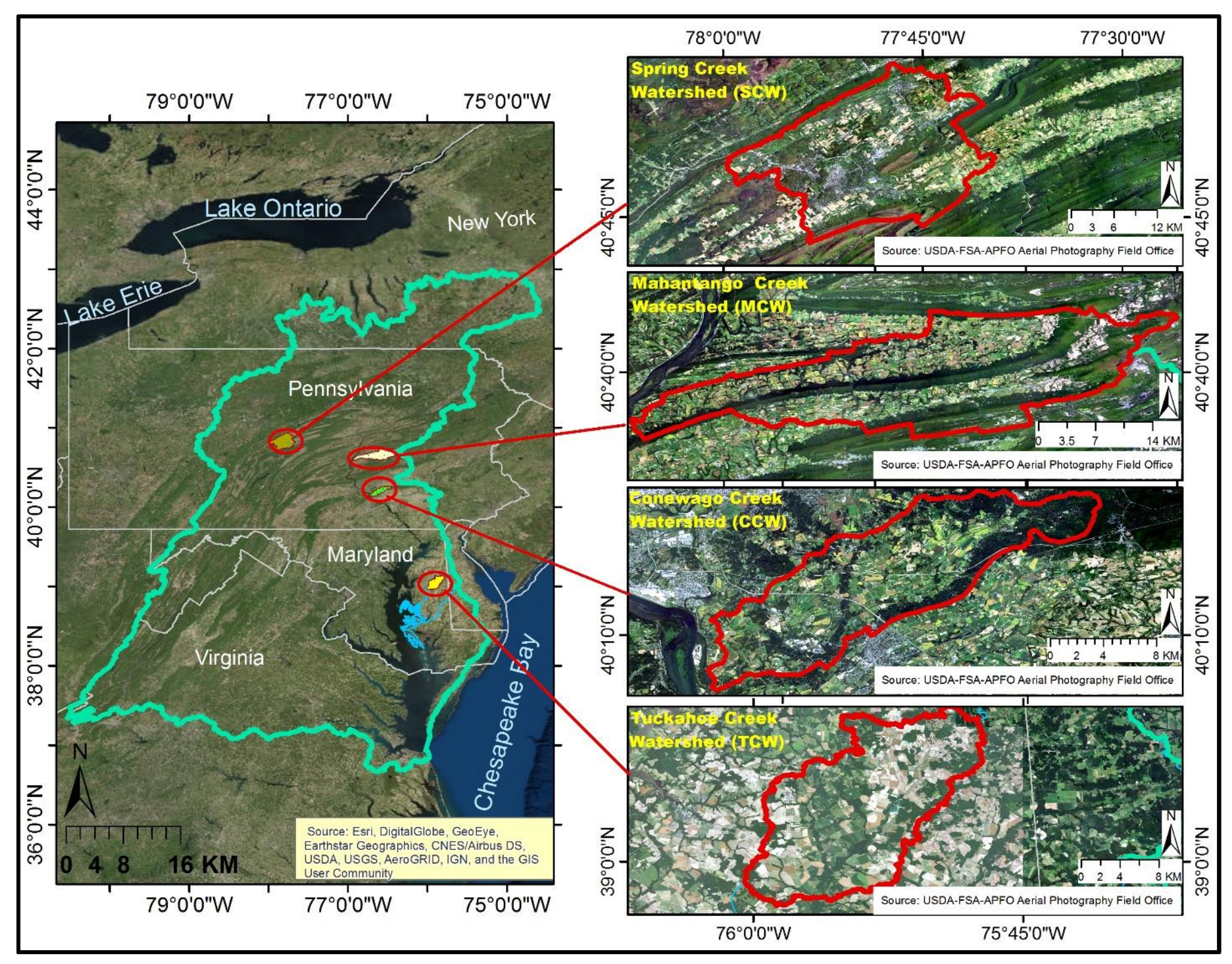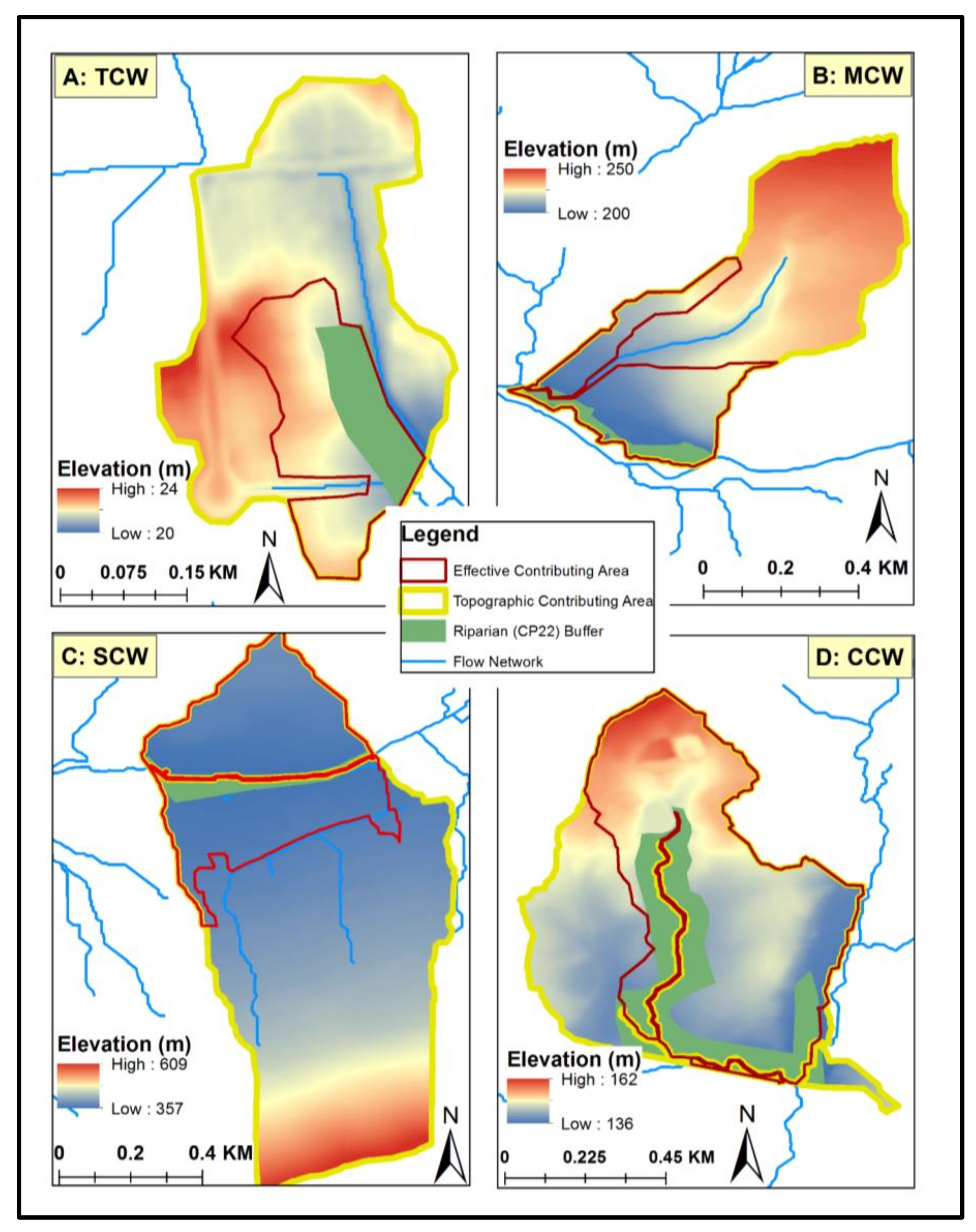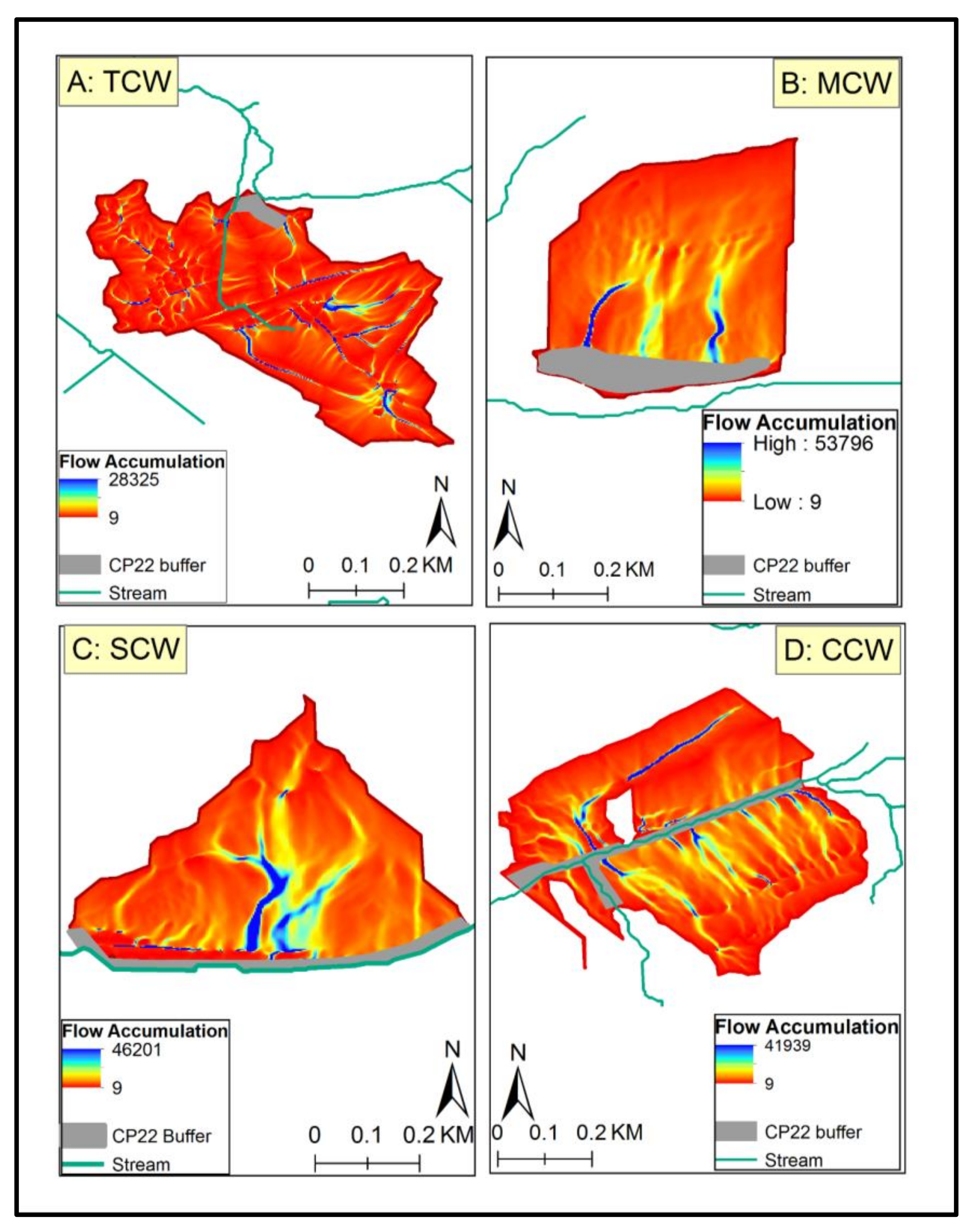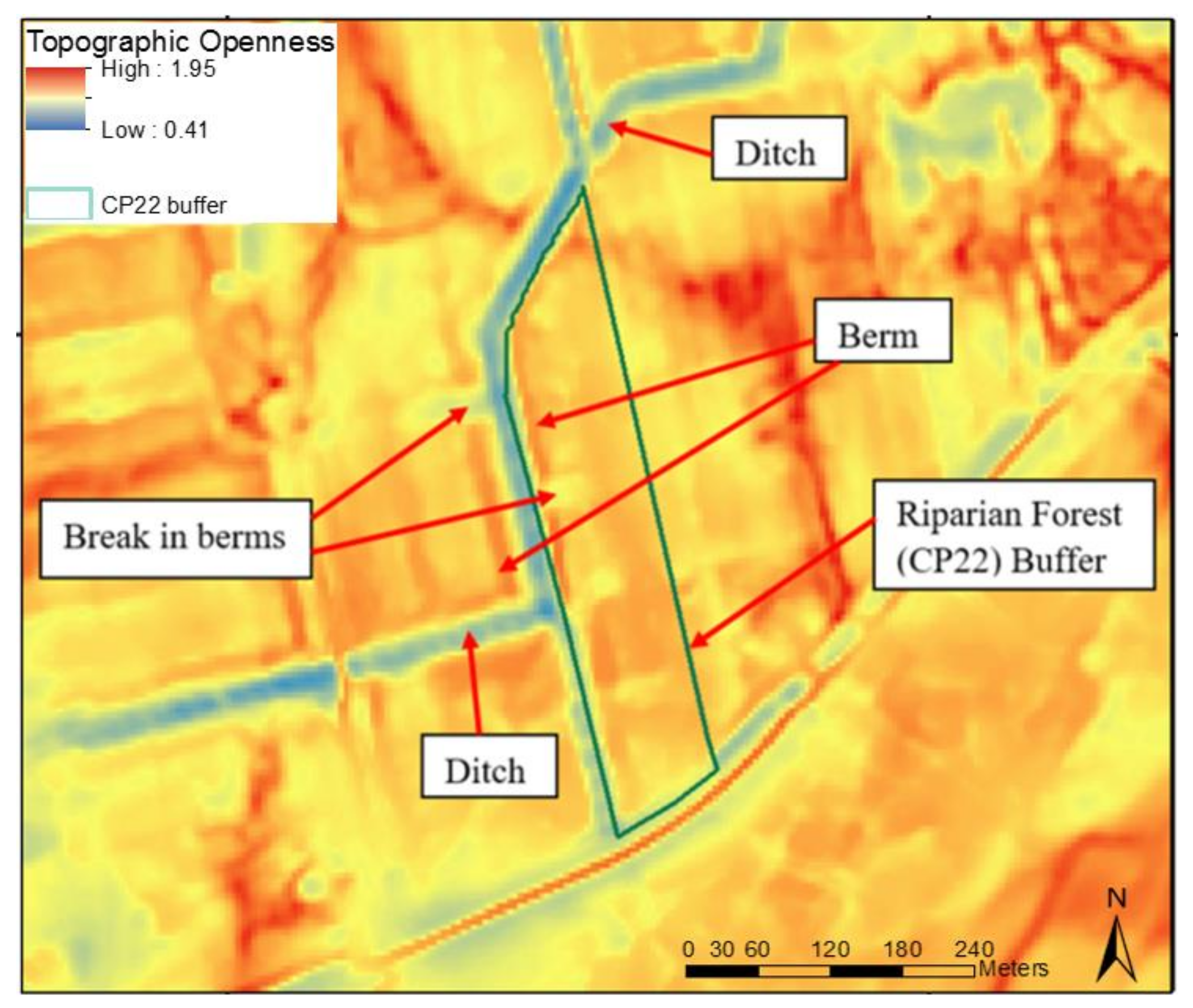Evaluating Concentrated Flowpaths in Riparian Forest Buffer Contributing Areas Using LiDAR Imagery and Topographic Metrics
Abstract
:1. Introduction
2. Materials and Methods
2.1. Study Area Description
2.2. Data Description
2.3. Topographic Analysis
3. Results
3.1. A Comparison of Topographic Metrics
3.2. Analysis of Hydrologic Bypass Features
4. Discussion
4.1. Performance of Topographic Metrics in Different Topographic Relief Areas
4.2. Effects of Hydrologic Bypass Features on CP22 Contributing Areas
5. Conclusions
Acknowledgments
Author Contributions
Conflicts of Interest
References
- Hirsch, R.M.; Moyer, D.L.; Archfield, S.A. Weighted regressions on time, discharge, and season (wrtds), with an application to Chesapeake Bay river inputs. J. Am. Water Resour. Assoc. 2010, 46, 857–880. [Google Scholar] [CrossRef] [PubMed]
- Russell, K.M.; Galloway, J.N.; Macko, S.A.; Moody, J.L.; Scudlark, J.R. Sources of nitrogen in wet deposition to the Chesapeake Bay region. Atmos. Environ. 1998, 32, 2453–2465. [Google Scholar] [CrossRef]
- Owens, M.; Cornwell, J.C. Sedimentary evidence for decreased heavy-metal inputs to the chesapeake bay. Ambio 1995, 24, 24–27. [Google Scholar]
- Shuyler, L.R.; Linker, L.C.; Walters, C.P. The Chesapeake Bay story—The science behind the program. Water Sci. Technol. 1995, 31, 133–139. [Google Scholar]
- Bauereis, E.I. Chesapeake experience—NPS Chesapeake challenge for sustainable development. Water Sci. Technol. 1992, 26, 2723–2725. [Google Scholar]
- Leight, A.K.; Slacum, W.H.; Wirth, E.F.; Fulton, M.H. An assessment of benthic condition in several small watersheds of the Chesapeake Bay, USA. Environ. Monit. Assess. 2011, 176, 483–500. [Google Scholar] [CrossRef] [PubMed]
- Inamdar, S.P.; Mostaghimi, S.; McClellan, P.W.; Brannan, K.M. BMP impacts on sediment and nutrient yields from an agricultural watershed in the Coastal Plain region. Trans. ASAE 2001, 44, 1191–1200. [Google Scholar] [CrossRef]
- Welsch, D.J. Riparian Forest Buffers: Function and Design for Protection and Enhancement of Water Resources; U.S. Department of Agriculture, Forest Service, Northeastern Area, State & Private Forestry, Forest Resources Management: Newtown Square, PA, USA, 1991; Volume 7.
- Sheridan, J.M.; Lowrance, R.; Bosch, D.D. Management effects on runoff and sediment transport in riparian forest buffers. Trans. ASAE 1999, 42, 55–64. [Google Scholar] [CrossRef]
- Lee, K.H.; Isenhart, T.M.; Schultz, R.C. Sediment and nutrient removal in an established multi-species riparian buffer. J. Soil Water Conserv. 2003, 58, 1–8. [Google Scholar]
- Jordan, T.; Correll, D.; Weller, D. Nutrient interception by a riparian forest receiving inputs from adjacent cropland. J. Environ. Qual. 1993, 22, 467–473. [Google Scholar] [CrossRef]
- Lowrance, R.; Altier, L.; Newbold, J.; Schnabel, R.; Groffman, P.; Denver, J.; Correll, D.; Gilliam, J.; Robinson, J.; Brinsfield, R.; et al. Water quality functions of riparian forest buffers in Chesapeake Bay watersheds. Environ. Manag. 1997, 21, 687–712. [Google Scholar] [CrossRef]
- Angier, J.; McCarty, G.; Prestegaard, K. Hydrology of a first-order riparian zone and stream, Mid-Atlantic Coastal Plain, Maryland. J. Hydrol. 2005, 309, 149–166. [Google Scholar] [CrossRef]
- Angier, J.; McCarty, G. Variations in base-flow nitrate flux in a first-order stream and riparian zone. J. Am. Water Resour. Assoc. 2008, 44, 367–380. [Google Scholar] [CrossRef]
- Shoemaker, R. The Conservation Reserve Program and Its Effect on Land Values; U.S. Department of Agriculture, Economic Research Service: Washington, DC, USA, 1989.
- Dosskey, M.G.; Helmers, M.J.; Eisenhauer, D.E.; Franti, T.G.; Hoagland, K.D. Assessment of concentrated flow through riparian buffers. J. Soil Water Conserv. 2002, 57, 336–343. [Google Scholar]
- Knight, K.W.; Schultz, R.C.; Mabry, C.M.; Isenhart, T.M. Ability of remnant riparian forests, with and without grass filters, to buffer concentrated surface runoff1. J. Am. Water Resour. Assoc. 2010, 46, 311–322. [Google Scholar] [CrossRef]
- Lyons, J.; Trimble, S.W.; Paine, L.K. Grass versus trees: Managing riparian areas to benefit streams of Central North America. J. Am. Water Resour. Assoc. 2000, 36, 919–930. [Google Scholar] [CrossRef]
- Myers, J.L.; Wagger, M.G.; Leidy, R.B. Chemical movement in relation to tillage system and simulated rainfall intensity. J. Environ. Qual. 1995, 24, 1183–1192. [Google Scholar] [CrossRef]
- Schultz, R.C.; Isenhart, T.M.; Simpkins, W.W.; Colletti, J.P. Riparian forest buffers in agroecosystems—Lessons learned from the Bear Creek watershed, Central Iowa, USA. Agrofor. Syst. 2004, 63, 35–50. [Google Scholar]
- Dillaha, T.A.; Sherrard, J.H.; Lee, D.; Mostaghimi, S.; Shanholtz, V.O. Evaluation of vegetative filter strips as a best management practice for feed lots. J. Water Pollut. Control Fed. 1988, 60, 1231–1238. [Google Scholar]
- Dillaha, T.A.; Reneau, R.B.; Mostaghimi, S.; Lee, D. Vegetative filter strips for agricultural nonpoint source pollution-control. Trans. ASAE 1989, 32, 513–519. [Google Scholar] [CrossRef]
- Daniels, R.B.; Gilliam, J.W. Sediment and chemical load reduction by grass and riparian filters. Soil Sci. Soc. Am. J. 1996, 60, 246–251. [Google Scholar] [CrossRef]
- Pankau, R.C.; Schoonover, J.E.; Williard, K.W.J.; Edwards, P.J. Concentrated flow paths in riparian buffer zones of Southern Illinois. Agrofor. Syst. 2012, 84, 191–205. [Google Scholar] [CrossRef]
- Mayer, P.; Reynolds, S.; McCutchen, M.; Canfield, T. Meta-analysis of nitrogen removal in riparian buffers. J. Environ. Qual. 2007, 36, 1172–1180. [Google Scholar] [CrossRef] [PubMed]
- Lee, K.; Isenhart, T.; Schultz, R.; Mickelson, S. Multispecies riparian buffers trap sediment and nutrients during rainfall simulations. J. Environ. Qual. 2000, 29, 1200–1205. [Google Scholar] [CrossRef]
- Liu, X.; Mang, X.; Zhang, M. Major factors influencing the efficacy of vegetated buffers on sediment trapping: A review and analysis. J. Environ. Qual. 2008, 37, 1667–1674. [Google Scholar] [CrossRef] [PubMed]
- Fox, G.; Sabbagh, G. Comment on “Major factors influencing the efficacy of vegetated buffers on sediment trapping: A review and analysis,” By xingmei liu, xuyang zhang, and minghua zhang in the journal of environmental quality 2008 37:1667-1674. J. Environ. Qual. 2009, 38, 1–2. [Google Scholar] [CrossRef] [PubMed]
- Piechnik, D.; Goslee, S.; Veith, T.; Bishop, J.; Brooks, R. Topographic placement of management practices in riparian zones to reduce water quality impacts from pastures. Landsc. Ecol. 2012, 27, 1307–1319. [Google Scholar] [CrossRef]
- Mausbach, M.; Dedrick, A. The length we go—Measuring environmental benefits of conservation practices. J. Soil Water Conserv. 2004, 59, 96A–103A. [Google Scholar]
- Wallace, C.; Flanagan, D.; Engel, B. Quantifying the effects of conservation practice implementation on predicted runoff and chemical losses under climate change. Agric. Water Manag. 2017, 186, 51–65. [Google Scholar] [CrossRef]
- Walbridge, M.R.; Shafer, S.R. A long-term agroecosystem research (ltar) network for agriculture. In Proceedings of the Fourth Interagency Conference on Research in the Watersheds, Fairbanks, AK, USA, 26–30 September 2011. [Google Scholar]
- USDA-NRCS (United States Department of Agriculture, N.R.C.S.). Official Soil Series Descriptions. Available online: https://soilseries.sc.egov.usda.gov/osdlist.aspx (accessed on 14 November 2017).
- Foyle, A.M.; Oertel, G.F. Seismic stratigraphy and coastal drainage patterns in the Quaternary section of the Southern Delmarva Peninsula, Virginia, USA. Sediment. Geol. 1992, 80, 261–277. [Google Scholar] [CrossRef]
- McCarty, G.; McConnell, L.; Hapernan, C.; Sadeghi, A.; Graff, C.; Hively, W.; Lang, M.; Fisher, T.; Jordan, T.; Rice, C.; et al. Water quality and conservation practice effects in the Choptank River watershed. J. Soil Water Conserv. 2008, 63, 461–474. [Google Scholar] [CrossRef]
- Bryant, R.; Veith, T.; Feyereisen, G.; Buda, A.; Church, C.; Folmar, G.; Schmidt, J.; Dell, C.; Kleinman, P. US Department of Agriculture Agricultural Research Service Mahantango Creek watershed, Pennsylvania, United States: Physiography and history. Water Resour. Res. 2011, 47, 8. [Google Scholar] [CrossRef]
- White, K.E. Regional Curve Development and Selection of a Reference Reach in the Non-Urban, Lowland Sections of the Piedmont Physiographic Province, Pennsylvania and Maryland; Pennsylvania Water Science Center: New Cumberland, PA, USA, 2001; 20p.
- Lang, M.; McCarty, G.; Oesterling, R.; Yeo, I. Topographic metrics for improved mapping of forested wetlands. Wetlands 2013, 33, 141–155. [Google Scholar] [CrossRef]
- Lang, M.; McCarty, G. LiDAR intensity for improved detection of inundation below the forest canopy. Wetlands 2009, 29, 1166–1178. [Google Scholar] [CrossRef]
- Carline, R.; Walsh, M. Responses to riparian restoration in the Spring Creek watershed, Central Pennsylvania. Restor. Ecol. 2007, 15, 731–742. [Google Scholar] [CrossRef]
- Conrad, O.; Bechtel, B.; Bock, M.; Dietrich, H.; Fischer, E.; Gerlitz, L.; Wehberg, J.; Wichmann, V.; Bohner, J. System for Automated Geoscientific Analyses (SAGA) v. 2.1.4. Geosci. Model. Dev. 2015, 8, 1991–2007. [Google Scholar] [CrossRef]
- Li, X.; McCarty, G.; Karlen, D.; Cambardella, C. Topographic metric predictions of soil redistribution and organic carbon in Iowa cropland fields. Catena 2018, 160, 222–232. [Google Scholar] [CrossRef]
- Yokoyama, R.; Shirasawa, M.; Pike, R. Visualizing topography by openness: A new application of image processing to digital elevation models. Photogramm. Eng. Remote Sens. 2002, 68, 257–265. [Google Scholar]
- Tarboton, D. A new method for the determination of flow directions and upslope areas in grid digital elevation models. Water Resour. Res. 1997, 33, 309–319. [Google Scholar] [CrossRef]
- Chu, H.; Huang, M.; Tain, Y.; Yang, M.; Hofle, B. Historic low wall detection via topographic parameter images derived from fine-resolution dem. ISPRS Int. J. Geo-Inf. 2017, 6, 346. [Google Scholar] [CrossRef]
- Prima, O.; Echigo, A.; Yokoyama, R.; Yoshida, T. Supervised landform classification of Northeast Honshu from dem-derived thematic maps. Geomorphology 2006, 78, 373–386. [Google Scholar] [CrossRef]
- Prima, O.; Yoshida, T. Characterization of volcanic geomorphology and geology by slope and topographic openness. Geomorphology 2010, 118, 22–32. [Google Scholar] [CrossRef]
- Inomata, T.; Pinzon, F.; Ranchos, J.; Haraguchi, T.; Nasu, H.; Fernandez-Diaz, J.; Aoyama, K.; Yonenobu, H. Archaeological application of airborne LiDAR with object-based vegetation classification and visualization techniques at the Lowland Maya site of Ceibal, Guatemala. Remote Sens. 2017, 9, 563. [Google Scholar] [CrossRef]
- Li, X.; McCarty, G.; Lang, M.; Ducey, T.; Hunt, P.; Miller, J. Topographic and physicochemical controls on soil denitrification in prior converted croplands located on the Delmarva Peninsula, USA. Geoderma 2018, 309, 41–49. [Google Scholar] [CrossRef]
- Heathwaite, A.; Quinn, P.; Hewett, C. Modelling and managing critical source areas of diffuse pollution from agricultural land using flow connectivity simulation. J. Hydrol. 2005, 304, 446–461. [Google Scholar] [CrossRef]
- Ghebremichael, L.; Veith, T.; Hamlett, J. Integrated watershed- and farm-scale modeling framework for targeting critical source areas while maintaining farm economic viability. J. Environ. Manag. 2013, 114, 381–394. [Google Scholar] [CrossRef] [PubMed]
- Ghebremichael, L.; Watzin, M. Identifying and controlling critical sources of farm phosphorus imbalances for Vermont dairy farms. Agric. Syst. 2011, 104, 551–561. [Google Scholar] [CrossRef]
- Gilliam, J.; Skaggs, R.; Weed, S. Drainage control to diminish nitrate loss from agricultural fields. J. Environ. Qual. 1979, 8, 137–142. [Google Scholar] [CrossRef]








| LTAR Watersheds | TCW | MCW | SCW | CCW |
|---|---|---|---|---|
| Number of CP22 buffers assessed | 11 | 25 | 3 | 13 |
| CP22 buffers affected by concentrated flowpaths | 8 | 11 | 1 | 7 |
| Total area of CP22 buffers (hectare) | 22.5 | 66.2 | 7.8 | 67.3 |
| Total potential (topographic) contributing area (hectare) | 258 | 488 | 189 | 644 |
| Total effective contributing area (hectare) | 57 | 381 | 87 | 400 |
© 2018 by the authors. Licensee MDPI, Basel, Switzerland. This article is an open access article distributed under the terms and conditions of the Creative Commons Attribution (CC BY) license (http://creativecommons.org/licenses/by/4.0/).
Share and Cite
Wallace, C.W.; McCarty, G.; Lee, S.; Brooks, R.P.; Veith, T.L.; Kleinman, P.J.A.; Sadeghi, A.M. Evaluating Concentrated Flowpaths in Riparian Forest Buffer Contributing Areas Using LiDAR Imagery and Topographic Metrics. Remote Sens. 2018, 10, 614. https://doi.org/10.3390/rs10040614
Wallace CW, McCarty G, Lee S, Brooks RP, Veith TL, Kleinman PJA, Sadeghi AM. Evaluating Concentrated Flowpaths in Riparian Forest Buffer Contributing Areas Using LiDAR Imagery and Topographic Metrics. Remote Sensing. 2018; 10(4):614. https://doi.org/10.3390/rs10040614
Chicago/Turabian StyleWallace, Carlington W., Gregory McCarty, Sangchul Lee, Robert P. Brooks, Tamie L. Veith, Peter J. A. Kleinman, and Ali M. Sadeghi. 2018. "Evaluating Concentrated Flowpaths in Riparian Forest Buffer Contributing Areas Using LiDAR Imagery and Topographic Metrics" Remote Sensing 10, no. 4: 614. https://doi.org/10.3390/rs10040614
APA StyleWallace, C. W., McCarty, G., Lee, S., Brooks, R. P., Veith, T. L., Kleinman, P. J. A., & Sadeghi, A. M. (2018). Evaluating Concentrated Flowpaths in Riparian Forest Buffer Contributing Areas Using LiDAR Imagery and Topographic Metrics. Remote Sensing, 10(4), 614. https://doi.org/10.3390/rs10040614





